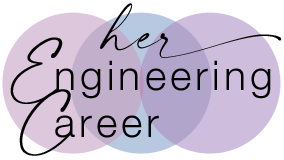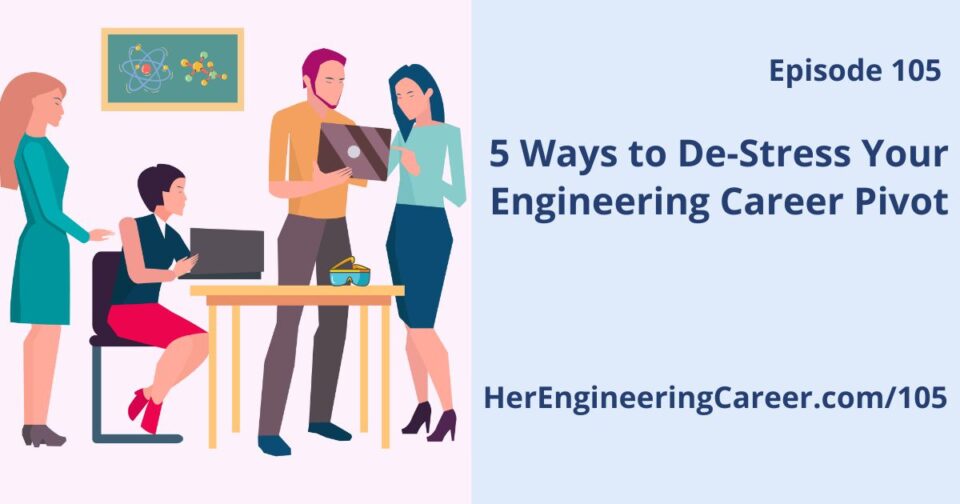Episode Transcript
You’ve found a great opportunity to make a career pivot. It’s giving a boost to your engineering career. And bringing you closer to your goals.
But you’re finding that such a change takes a lot out of you.
It was the right thing to do. A good match for your strengths and abilities.
But nonetheless it’s a big change. And, you’re not afraid to admit, a little daunting.
You successfully completed your career pivot. But now you’re faced with a new work environment, a new set of people and a whole new set of engineering challenges.
Your stress level is still high. Perhaps your biggest test is yet to come.
Strategize a More Easeful Transition After Your Engineering Career Pivot
But there is some strategy you can apply here. With a few simple tactics, you can structure an approach that eases you in to your new role. That lowers the stress you feel as you take on new responsibilities.
Here are 5 ways to ease the strain you feel as you begin work after a career pivot:
- Connect with Key People
Getting to know the people in your new work environment will go a long way to reducing the stress of your job change.
Even if you’re in the same organization and already know some of these people, it’s a good idea to set up a series of one-on-one meetings.
Meet with your boss and other leaders to learn their approaches, preferences and advice. Find out their philosophies and their expectations of you.
Meet with colleagues and teammates to get their perspectives and ideas. People you’ll be working with can share their learnings and practices. Their likes and dislikes.
And you’ll gain valuable insight from people who will be working for you or on your team.
Also be sure to ask others who else they recommend you connect with.
- Tell Your Story
There’s a 2-way benefit to telling your story: People want to know about you. About how you can help them. And what value you can add.
When people know about you, they’re much more welcoming and inclusive. They become less hesitant to work with you. And more likely to help you integrate and find opportunities.
So share your career message. Use the Magic 4 that we talked about in Episode 94. Tell others why you’re here. Why you pivoted into their organization and what their mission means to you.
And let people know your own perspectives and ideas. Share how you plan to have impact. What you bring. Your strengths and talents. And your goals and aspirations.
- Become an Insider
Initially you’ll feel like an outsider after your career pivot. It’s uncomfortable. I know. But the sooner you can address this, the sooner this feeling fades. And you’ll be one of the team.
Learn the culture and norms of your new organization. Ask questions. You’re the new kid. So you can play your new kid card and ask lots of questions.
BTW, here’s a Tip for newbies: Be up front and acknowledge what you don’t know.
So many times during my career I was afraid to let people know what I didn’t know. I thought it would damage my career. That people would think less of me as an engineer.
But that’s not the case at all. People don’t expect you to know everything when you first come in. Or ever, really.
Acknowledge what you don’t know. Ask questions. And take notes so you can research concepts and ideas that you want to learn about.
Also be flexible. Be willing to learn and accepting of differences. Become aware of where you might suggest changes or make improvements, while still being respectful of current practices.
- Find Your Fit
Whoever interviewed you or invited you to make this career pivot sees something in you that’s a good fit for their team and their mission.
Knowing this, and knowing your energetic center, find where you fit best. Find where you can apply your strengths. Focus where you can add most value.
Perhaps you were brought in to work a certain project. Start there. Make that project yours.
You can use it to showcase your skills and talents, but also to learn about your new people and your new responsibilities.
And if you’re not assigned a starter project, ask for help in finding one on your own.
As you work this project you’ll find more ways to align who you are with what you do. And this, of course, is where you’ll do your best work.
- Give it Time
How long it will take you to ease the stress of your career pivot depends on many things. But, giving yourself ample time and space to let that happen for you is part of what keeps your stress level low.
A Career Pivot is Uncomfortable, But Only Momentarily
One thing I know for sure is that it gets easier.
Hopefully you’ll have opportunities to make multiple pivots in your engineering career. And after a couple times, you’ll get the hang of getting settled in your new place.
It’s through the pivot process that you improve your networking skills, learn to solve new kinds of problems, and broaden your outlook for future engineering and leadership opportunities.
It’s temporarily uncomfortable. But you can handle it. And you’ll be that much closer to becoming the engineer and leader you want to be.
I’m ready to help you through any of your engineering career transitions. If you’re struggling with post-pivot stress, sign up for a strategy session with me so we can find the approaches that work for you.
Next time on Her Engineering Career Podcast we’ll explore how to find your way when you’re struggling to get on the right engineering career trajectory. I hope you’ll join me for Episode 106.

